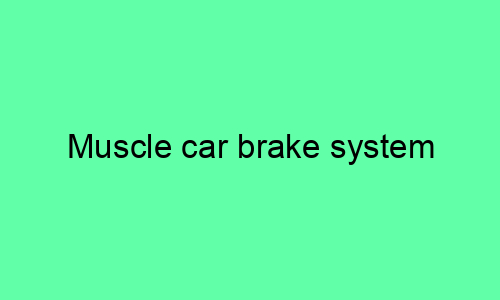Muscle Car Brake System
Introduction
Muscle cars are high-performance vehicles that require a powerful and reliable brake system. The brake system is responsible for slowing down and stopping the car, and it must be able to do so quickly and effectively. Muscle cars often have large, heavy engines that produce a lot of torque, so the brake system must be able to handle the increased stopping power.
Components of a Muscle Car Brake System
The brake system in a muscle car typically consists of the following components:
* **Brake pads:** The brake pads are the main components that apply friction to the brake rotors, slowing down the car. Brake pads are made of a variety of materials, including ceramic, semi-metallic, and organic. Each type of brake pad has its own advantages and disadvantages, so it is important to choose the right type of brake pad for your muscle car.
* **Brake rotors:** The brake rotors are the discs that the brake pads press against to slow down the car. Brake rotors are typically made of cast iron or steel, and they are often vented to help dissipate heat.
* **Brake calipers:** The brake calipers are the components that house the brake pads and apply pressure to them. Brake calipers are typically made of aluminum or steel, and they are mounted to the wheel hubs.
* **Brake lines:** The brake lines are the tubes that carry brake fluid from the master cylinder to the brake calipers. Brake lines are typically made of steel or rubber, and they must be able to withstand high pressure.
* **Master cylinder:** The master cylinder is the component that generates the hydraulic pressure that is used to apply pressure to the brake pads. The master cylinder is typically mounted to the firewall, and it is connected to the brake pedal.
How a Muscle Car Brake System Works
When you press the brake pedal, the master cylinder generates hydraulic pressure that is sent through the brake lines to the brake calipers. The brake calipers then apply pressure to the brake pads, which press against the brake rotors. This friction slows down the car.
The amount of pressure that is applied to the brake pads is determined by the amount of force that you apply to the brake pedal. The harder you press the brake pedal, the more pressure is applied to the brake pads and the faster the car will slow down.
Maintenance of a Muscle Car Brake System
The brake system in a muscle car is a critical safety feature, so it is important to keep it in good working condition. You should have your brake system inspected and serviced regularly by a qualified mechanic.
Some of the most common brake system maintenance tasks include:
* **Inspecting the brake pads:** The brake pads should be inspected regularly for wear and tear. If the brake pads are worn down, they should be replaced.
* **Inspecting the brake rotors:** The brake rotors should be inspected regularly for wear and tear. If the brake rotors are warped or damaged, they should be replaced.
* **Inspecting the brake calipers:** The brake calipers should be inspected regularly for leaks and wear. If the brake calipers are leaking or damaged, they should be replaced.
* **Flushing the brake fluid:** The brake fluid should be flushed regularly to remove any contaminants. Brake fluid should be flushed every two years or 24,000 miles, whichever comes first.
Conclusion
The brake system in a muscle car is a critical safety feature that must be maintained in good working condition. By following the maintenance tips outlined in this article, you can help to ensure that your muscle car’s brake system is always working properly.






